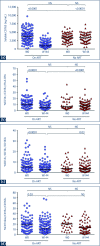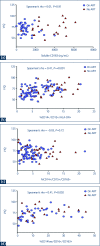Soluble CD163 and monocyte populations in response to antiretroviral therapy and in relationship with neuropsychological testing among HIV-infected children
- PMID: 26835517
- PMCID: PMC4729380
- DOI: 10.1016/S2055-6640(20)30501-X
Soluble CD163 and monocyte populations in response to antiretroviral therapy and in relationship with neuropsychological testing among HIV-infected children
Abstract
Background: Monocytes play a central role in HIV neuropathogenesis, but there are limited data on monocyte subsets and markers of monocyte activation in perinatally HIV-infected children.
Objective: To determine the relationship between monocyte subsets, the sCD163 monocyte activation marker, and neuropsychological performance among perinatally HIV-infected children initiating antiretroviral therapy (ART).
Methods: ART-naïve children from the PREDICT study were categorised into two groups: those on ART for ≥24 weeks (ART group, n =201) and those untreated (no ART group, n =79). This analysis used data from the baseline and week 144 including sCD163 and frequencies of activated monocytes (CD14+/CD16+/HLA-DR+), perivascular monocytes (CD14+/CD16+/CD163+ and CD14low/CD16+/CD163+), and neuropsychological testing scores: Verbal and Performance Intelligence Quotient (VIQ and PIQ), Beery Visuomotor Integration (VMI) and Children's Color Trails 2 (CT2).
Results: Baseline demographic and HIV disease parameters were similar between groups. The median age was 6 years, CD4 was 20% (620 cells/mm3), and HIV RNA was 4.8 log10. By week 144, the ART vs the no ART group had significantly higher CD4 (938 vs 552 cells/mm3) and lower HIV RNA (1.6 vs 4.38 log10 copies/mL, P <0.05). sCD163 declined in the ART vs no ART group (median changes -2533 vs -159 ng/mL, P <0.0001). Frequencies of all monocyte subsets declined in the treated but not the untreated group (P <0.05). Higher CD14+/CD16+/HLA-DR+ percentage was associated with higher VIQ, Beery VMI and CT2 scores. Higher percentages of CD14+/CD16+/CD163+ and CD14low/CD16+/CD163+ were associated with higher CT2 and VIQ, respectively.
Conclusion: ART significantly reduced sCD163 levels and frequencies of activated and perivascular monocytes. Higher frequencies of these cells correlated with better neuropsychological performance suggesting a protective role of monocyte-macrophage immune activation in perinatal HIV infection in terms of neuropsychological function.
Keywords: ART; HIV; children; immune activation; monocyte; neurocognition; neuropsychological testing; sCD163.
Figures


References
-
- Puthanakit T, Ananworanich J, Vonthanak S et al. . Cognitive function and neurodevelopmental outcomes in HIV-infected Children older than 1 year of age randomized to early versus deferred antiretroviral therapy: the PREDICT neurodevelopmental study. Pediatr Infect Dis J 2013; 32: 501– 508. - PMC - PubMed
-
- Smith R and Wilkins M.. Perinatally acquired HIV infection: long-term neuropsychological consequences and challenges ahead. Child Neuropsychol 2015; 21: 234– 268. - PubMed
Grants and funding
LinkOut - more resources
Full Text Sources
Research Materials
